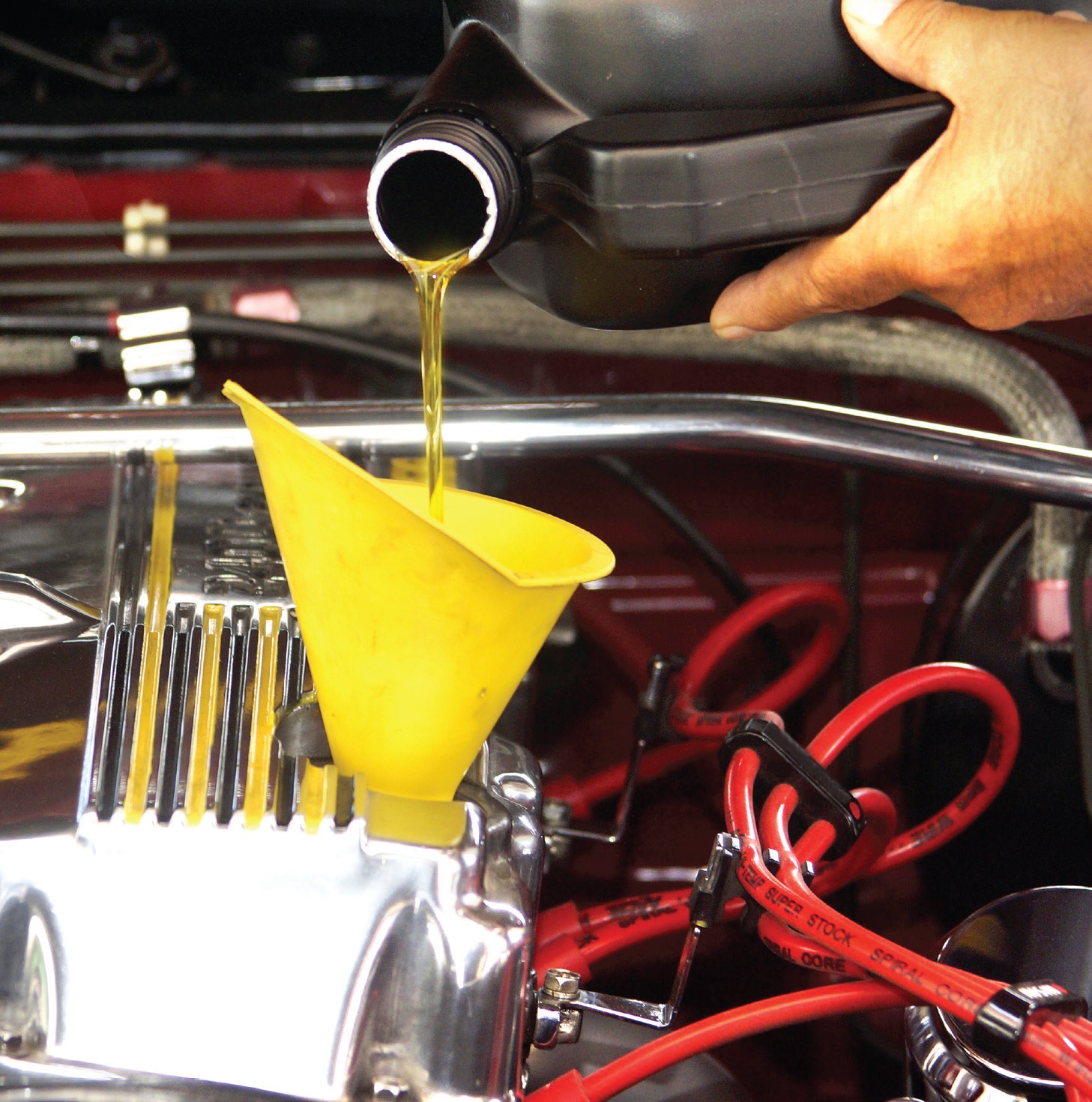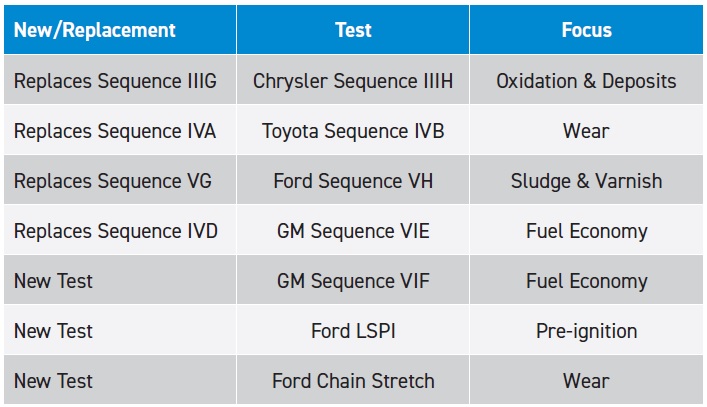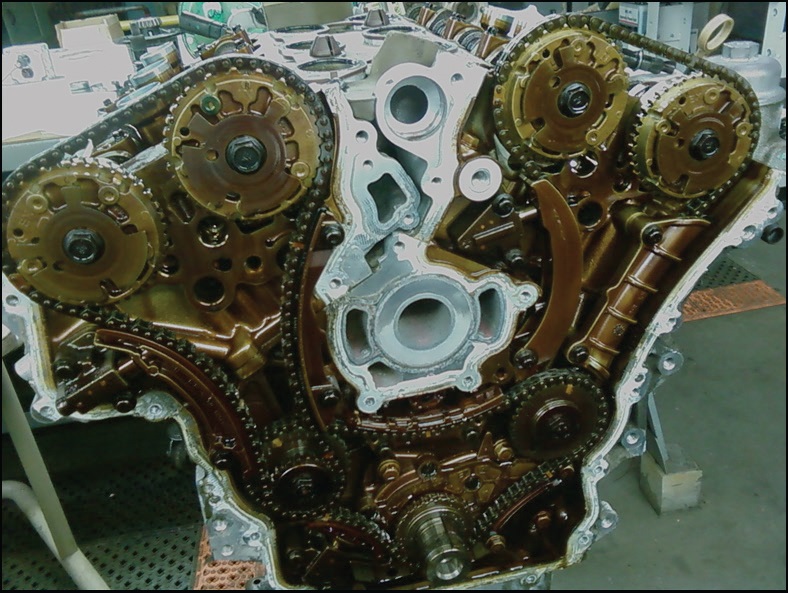Countdown to GF-6
Jeanna Van Rensselar, Senior Feature Writer | TLT Feature Article August 2018
Formulators are collaborating feverishly to avoid further delays and eliminate inefficiencies for future categories.

© Can Stock Photo / Pixelia29
KEY CONCEPTS
•
Meeting fuel efficiency standards with lower viscosity oil without compromising protection in today’s engines remains a challenge.
•
OEMs and oil formulators, no longer able to wait any longer for LSPI protection, rushed API SN Plus into existence. Additive companies developed the additive technology to address LSPI earlier.
•
While engine test development continues to be the time-limiting factor in new category development, OEMs and formulators are working diligently together to prevent further delays in GF-6 and to avoid inefficiencies in future category development.
With fuel efficiency standards that will continue to tighten, passenger vehicle and light-truck OEMs are working hard to increase fuel efficiency while at the same time maintaining engine performance and, more important, engine protection (
1). Although some, like Chevron’s Matthew Ansari, say that for the most part performance and protection are one and the same.
Meeting fuel efficiency standards without compromising protection is requiring the brain power of engineers across the globe. While historically lubricants only improve fuel efficiency no more than 3%, it’s a 3% OEMs are happy to accept.
One contribution the auto industry is counting on from lubricant formulators is lower-viscosity GF-6 engine oils—also known as International Lubricants Standardization and Approval Committee (ILSAC)-spec GF-6. These oils will deliver performance improvements over the current ILSAC GF-5 specification.
The issue now is that GF-6 oils are still in development and have not yet been approved for licensing. Continued licensing delays have mostly been due to tests that are awaiting approval. The original target date for approval was in 2016; the current date for now is some time in 2020. There is continuous progress toward first licensing, but it’s taking longer than expected.
Meanwhile, high-performance vehicles have been rolling off the assembly line for years that desperately need what GF-6 oils have to offer. Formulators are making due with workarounds that are effective (
see A GF-6 Timeline).
A GF-6 timeline (2)
•
December 2014. Good progress on test development. Sequence VIE and VH almost approved. LSPI, oxidation and Sequence IIIH still require work.
•
March 2015. It is expected that all the new tests would be ready to begin industry precision matrix work before Q2 2015.
•
June 2015. Although tests made good progress, none had started its precision matrix and none are expected to start before Q3 2015. First licensing date is expected to slip to Feb. 1, 2018.
•
September 2015. Timing slips to April 1, 2018. Real issues and debates arose concerning some of the new tests, and only the Sequence IIIH had started its precision matrix.
•
December 2015. Slow progress continues. The number of new tests means the industry is dealing with some significant test issues, which are expected to further delay the category.
•
March 2016. Precision matrices begin for chain wear, Sequence VIE and LSPI tests. The Sequence VG-A is expected to be ready by May 2016. The MHT-4 test is removed from the ILSAC GF-6 specification.
•
June 2016. Industry stakeholders acknowledge that delay is inevitable and work to define a new timeline. This is a significant concern for OEMs who want to use ILSAC GF-6 technology for their MY 2019 engines.
•
September 2016. The slow pace of test development and approval delay the new category, and first allowable use is not expected before Q4 2018.
•
December 2016. Test development continues to move forward slowly, but timing for ILSAC GF-6 is unclear, and it appears first allowable use could slip into 2019 if any test experiences a significant delay.
•
April 2017. It is expected that first licensing will slip into 2019. ILSAC GF-6 may not be ready for MY 2019 vehicles.
•
June 2017. Test development continues to be the major challenge. The first allowable use date is expected to slip well into 2019.
•
September 2017. An API SN supplement is requested by OEMs to include an LSPI test to deliver turbocharger protection.
•
May 2018. API SN Plus is licensed. The Sequence IVB wear test is accepted into ILSAC GF-6.
Some basics about GF-6 (3)
•
GF-6 engine oils will offer better protection for new technologies such as gasoline direct injection (GDI) and turbocharged gasoline direct injection (TGDI) engines. Estimates are that by 2020 39% of vehicles sold will be powered by GDI/TGDI engines.
•
GF-6 is split into two categories:
o
GF-6A. Addresses traditional viscosities and will be fully backward compatible with ILSAC GF-5 but with better fuel economy and engine protection, plus improved performance while maintaining durability.
o
GF-6B. Represents viscosity grades lower than SAE 0W20 (ultra-low viscosity or ULV lubricants) and will not be backward compatible. It should deliver performance similar to ILSAC GF-6A but will cover lower viscosity oils, like XW-16, in order to take advantage of the fuel economy benefits (
see Low-Viscosity Engine Oil and Engine Protection).
•
GF-6 engine oils will address the need for increased engine protection for more severe engine designs.
•
A reduction in GF-6 HTHS (high-temperature high-shear) viscosity limits will help fuel economy, but this means oil manufacturers will have to address engine protection with technologically advanced additives and base oils.
•
Seven new engine tests were introduced to verify GF-6 engine oils for use in fuel economy and new technologies. Developing some of these tests is causing delays.
Low-viscosity engine oil and engine protection (4)
HTHS (high-temperature high-shear) viscosity is a critical property of engine oil that relates to fuel economy and durability (viscosity as it relates to hydrodynamic lubrication) of an engine. The drivers behind lowering HTHS viscosity are new global governmental regulations to improve fuel economy and lower greenhouse gases (GHGs) in new vehicles. Lower HTHS viscosity tends to improve fuel economy and lower GHG, but higher HTHS viscosity delivers better wear protection. So formulators need to strike a careful balance. Sufficient HTHS viscosity is critical to preventing engine wear at key interfaces.
One method used to measure HTHS viscosity is ASTM D4683. For this test, oil is introduced between a rotor and a stator at the test temperature of 150 C (302 F). The rotor experiences a reactive torque to the oil's resistance to flow (viscose friction) and this torque response level is used to determine the HTHS viscosity.
Matthew Ansari, staff scientist in charge of Passenger Car Motor Oil Product Development for Chevron Lubricants at the Richmond, Calif., Chevron Technical Center, says, “Protection
is performance, unless you qualify that by protection versus
fuel economy. Today’s engines are far more complex machines compared to what was available in the past. So we need to build more protection in there without compromising fuel economy performance."
He adds, “Lower viscosity does contribute to fuel economy by lowering pumping losses. Thinner oil is easier to pump. The issue has always been that thicker oil is perceived to offer better protection. Advances in additive systems, advancement in base oil quality that prevents oil from breaking down and the changes in engine component design all are enabling lower viscosity oils without compromising protection.”
As more engine makers aim to push the use of low viscosity oils for their products, mainly in a bid to comply with ever-tighter fuel economy mandates, fleets are voicing concerns about the long-term protective capability of thinner oil—a concern lubricant makers are trying to dispel via a variety of outreach efforts. Any fuel economy savings generated from using low viscosity oils won’t be worth it if the protective capability of the oil is compromised (
5).
Josh Frederick, OEM technical manager for Valvoline in Lexington, K.Y., says, “All indications are that lower viscosity oils can be formulated to protect modern engines
that are specifically designed to run with lower viscosity lubricants.”
The final standard will deliver a number of improvements over ILSAC GF-5, such as fuel economy, engine protection and remediation of issues with high-performance engines already on the road.
Legislative drivers
According to U.S. EPA, light-duty vehicles account for 60% of U.S. transportation-related petroleum usage and greenhouse gas (GHG) emissions. This prompted EPA to establish regulations for GHG emissions under the Clean Air Act. OEMs are working hard to meet Phase 2 of these regulations, which apply to model year (MY) 2017-2025 passenger cars, light-duty trucks and medium-duty passenger vehicles such as SUVs. In theory, this will result in MY 2025 vehicles emitting half the GHG emissions of a MY 2010 vehicle.
EPA suggests this legislation will save four billion barrels of oil and reduce GHG emissions by the equivalent of approximately two billion metric tons over the lifetime of the light-duty vehicles produced in MYs 2017-2025. Even if the current administration revises the 2025 mandate, the trend toward lower GHG emissions and high fuel economy will continue but in an extended timeframe (
6).
GF-6 and drain intervals
Increased engine oil robustness is specified as part of the ILSAC GF-6 needs statement. This is measured through various engine tests such as the Sequence IIIH. With the increasing restrictiveness of these tests, formulators are tasked with choosing the appropriate additive chemistry, base oils, etc.
However, with the priority to protect new engines with new oils and the focus on fuel efficiency, the question becomes: Just how important is extending the drain interval anymore?
Matthew Ansari, staff scientist in charge of Passenger Car Motor Oil Product Development for Chevron Lubricants at the Richmond, Calif., Chevron Technical Center, says, “Drain interval is not something that most oil companies like to get into. We don’t want to recommend anything that can be counter to what the OEM is asking for. Longer drain interval in and of itself is somewhat desirable. But it presents challenges to formulators as well as OEMs. For one thing, to enable a longer drain you need to allow more oil in the crankcase. Now you are lugging that oil around as you drive; that is added weight and you are losing fuel economy.”
He continues, “Most newer cars have systems onboard that will monitor the driving pattern to make sure that the oil is not stressed—to figure out how soon you should change your oil. The technology has been around long enough that it has scaled and brought the cost down—it is not just for luxury cars anymore. This means the concept of
longer drain interval has become somewhat less pressing. It is more important to have an accurate picture of the oil’s condition—which is what these monitoring systems provide.”
Chris Castanien, P.E., technical services manager-Americas for Neste in Brick, N.J., says, “Formulators are moving to Group III base oils not because of longer drain intervals. They are moving because OEMs want better fuel economy, and thinner oils create less drag. Group III and PAO are the only base oils that will let you formulate 0W-20 and lighter oils that will maintain the existing drain intervals. This is a key point and poorly understood.”
According to Castanien, it’s possible to have a relatively long drain interval with a 10W-40 or 5W-40. But at 0W-20 levels, which are where GF-6 comes in, the oil’s volatility becomes a major factor. The engine oil literally evaporates, exiting through the tailpipe, and raises the possibility of having no lubricant in the engine.
“If you don’t want to put an engine oil level sensor in the vehicle, then you need to specify tight volatility limits when you ask for lower viscosity grades—and that’s what the OEMs have done,” Castanien says. “API GF-6 will have a 15% Noack evaporation loss limit (
7). Some in Germany are talking about 11% or lower. The only way to do this is with Group III/IV.”
Ansari concludes, “When we are looking at technical challenges—extended drain is not a challenge—it is a balance of meeting the other requirements. Everyone is trying to achieve the requirements that are driving this industry, which is primarily fuel economy—what oil can contribute to it—because every little bit immediately projects across the car population. The No. 1 fuel economy variable is the driver, which can account for up to 35%. Other factors are aerodynamics, choice of tire and proper inflation, etc. Some of this is built in—such as aerodynamics and some of this is variable, such as tire choice and inflation.”
Turbocharging
A primary OEM tool for reducing fuel consumption without affecting torque and power is to reduce engine displacement and recoup the power through turbocharging. But nothing is free. These downsized and boosted engines come with a signature destructive combustion event called LSPI (low-speed pre-ignition). If left unchecked, TGDI engines also produce a unique soot-producing carbon contaminant that contributes to accelerated timing chain wear (
see What is Accelerated Timing Chain Wear?).
What is accelerated timing chain wear? (8)
Because of direct fuel injection into the combustion chamber, particulate matter has been a problem primarily for diesel engines. However, today’s gasoline direct injection engines also are vulnerable to higher soot or particulate matter levels and faster oil degradation—which cause timing chain wear.
The metal timing chain drives the camshaft(s) off of the crankshaft. Excessive wear can trigger the check engine light and could result in very expensive internal engine hardware repair. Excess wear is evident in chain elongation, which can disturb valve timing leading to degraded performance and higher engine out emissions. Researchers have not yet pinpointed the exact wear mechanism—it could be abrasive wear from carbon particles suspended in the lube oil or an interaction between carbon particles and the lubricant or both. The rate of chain wear depends on factors such as engine operation, chain design, chain materials, type of chain lubrication as well as engine oil.
Nathan Siebert, General Motors’ engineering group manager-Fluids and Lubricants, says, “Today’s new engines are typically turbocharged and have a higher operating temperature than their predecessors—putting a greater strain on engine oil.”
What to do about LSPI
LSPI occurs unpredictably prior to the spark trigger and is often followed by heavy knock, similar to but more impactful than traditional engine knock common in older vehicles. Drivers are generally not aware of LSPI and the catastrophic engine failure that it can cause until it is too late. This is why it’s critical that OEMs are on top of the situation and promote specially formulated lubricants to vehicle owners.
Lubricant additives are proving extremely effective in reducing LSPI frequency and intensity. Some oil formulators and OEMs have already brought solutions to the market to mitigate LSPI. These solutions include advanced additive technology solutions specifically designed to address LSPI throughout the oil drain interval.
Josh Frederick, OEM technical manager for Valvoline in Lexington, Ky., says, “Engine oil technology will continue to evolve throughout the foreseeable future. Increasing fuel efficiency requirements—and the engine enhancements that facilitate them—will continue to present performance challenges for engine oil formulators. In addition, unanticipated needs will likely arise. For example, in the quest for higher power density and greater efficiency, engine makers have increasingly employed turbocharged gasoline direct injection (TGDI) technology.”
He continues, “The high cylinder pressures and low operating speeds common in these engines have come with an unintended side effect: LSPI. In some cases, LSPI results in piston failures in modern engines. Recent research has shown that the occurrence of LSPI can be greatly reduced through the use of new engine oil chemistries.”
API SN Plus
Vehicles with gas direct injection and turbocharged gas direct injection engine technology are becoming more common. Today there are more than 26 million vehicles on U.S. roads with T/GDI engines. In 2024 vehicles equipped with T/GDI engines will make up nearly 83% of U.S. vehicle production (
9). All of these vehicles are susceptible to LSPI and accelerated timing chain wear. New GF-6 oils will address these issues, but OEMs can’t wait until the next projected licensing date in 2020.
In the meantime, there are API SN Plus oils. This is an interim formulation—currently available in most oils—that will protect against LSPI until GF-6 is licensed.
“Chevron introduced oils to protect against LSPI in its premium line of products early,” Ansari explains. “But for a while, OEMs have been asking for a performance parameter that protects against LSPI. There is a formulation angle that protects against LSPI, which helped pave the way for introducing API SN Plus supplement. It has been out since early 2018 to offer protection against LSPI and provide some relief to many OEMs. Chevron is not planning to market this as a separate oil. This protection is designed to be part of current formulations.”
The lubricant industry introduced SN Plus at the request of automakers and as a necessary response to repeated delays to ILSAC GF-6. The main addition to API SN for qualifying against SN Plus is a test to measure an oil’s ability to protect against LSPI.
Frederick explains, “In July of last year, automakers penned a formal request to API to develop a supplement to the existing engine oil category (ILSAC GF-5/API SN), requiring oils to demonstrate resistance to LSPI. The resulting supplement, API SN Plus, was rushed into existence with a first license date of May 1, 2018. This change required significant reformulation efforts on the part of additive companies and oil marketers in a very short period of time (
10).”
Beginning on that date, lubricant marketers were
officially permitted to sell products complying with SN Plus specifications and bearing the American Petroleum Institute donut trademark. However, at least one OEM, after evaluating their options for dealing with LSPI, took action a while ago.
Tests and delays
In addition to the need for performance improvements, the gap left by the elimination of a significant number of traditional engine tests also is a key factor driving the need for ILSAC GF-6 (by far the biggest turnover of tests for a new category) (
see Table 1).
Table 1. ILSAC GF-6 Tests and Replacement Tests
 Table courtesy of Infineum. Available here.
Table courtesy of Infineum. Available here.
The new GF-6 specification includes an unprecedented seven new engine tests. Five tests progressed through development uneventfully, including the LSPI test, the timing chain wear test (
see Figure 1), the Sequence IIIH oxidation and deposit test, and the Sequence VIE and VIF fuel economy tests.
 Figure 1. A typical timing chain connecting the crankshaft and the overhead cams. (Figure courtesy of Lubrizol.)
Figure 1. A typical timing chain connecting the crankshaft and the overhead cams. (Figure courtesy of Lubrizol.)
Two tests have proven particularly challenging to complete:
•
The Sequence IVB test evaluates a lubricant’s ability to prevent wear in modern valve trains.
•
The Sequence VH test evaluates a lubricant’s ability to prevent engine deposit buildup, more commonly known as
sludge and varnish (
11).
The Sequence IVB wear test was finally accepted into ILSAC GF-6 on May 10. This removed one of the last major hurdles for GF-6 approval, setting it on track to come to market around the second quarter of 2020.
Ansari says, “There were delays because of test developments—the valve train wear test in particular. There have been a number of reworks in the last 18 months. The delay caused by the valve train wear test was the most vexing. But we are making progress. First licensing is predicted for some time in July/August 2020.”
How to avoid delays like GF-6
The four-plus year delay in GF-6 highlights the unpredictable delays associated with developing seven new engine tests at the same time.
According to Frederick, “The time-limiting factor for a new specification, whether an industry spec or an OEM spec, is the development of new engine tests that exhibit discrimination, repeatability and reproducibility. Unfortunately, this development work can be quite resource intensive" (
see Developing a New Specification).
Developing a new specification (12, 13)
Many industry groups play a critical role in the development and oversight of new and existing engine oil performance categories. In North America, the Auto-Oil Advisory Panel is responsible for defining new specifications in passenger vehicles (for heavy-duty vehicles that would be the Diesel Engine Oil Advisory Panel—DEOAP).
There are two groups that report to the Auto-Oil Advisory Panel: the oil contingent—comprised of oil blenders/marketers and additive suppliers—and the automobile contingent—comprised of U.S., Japanese and other auto engine manufacturers. Collectively, the blenders, marketers, additive suppliers and engine manufacturers agree on the tests needed to evaluate engine oils and quantify performance in areas such as fuel economy, wear and sludge prevention and deposit control. They also develop parameters needed to demonstrate appropriate performance in each test.
Also involved is The Society of Automotive Engineers (SAE), which defines viscosity grades through its SAE J300 specification. ASTM International is responsible for developing precise industry standard test procedures. Finally, the American Petroleum Institute (API) licenses the approved oils for the marketplace.
While engine test development will continue to be a challenge, last year API chartered a group dedicated to address inefficiencies in future category development efforts. This group, the Lubricant Standards Development Review Group, includes representatives from each of the key interest groups (oil marketers, additive companies, base stock manufacturers, automakers and engine manufacturers).
 © Can Stock Photo / Productionperig
© Can Stock Photo / Productionperig
As Ansari points out, “API has been reporting good progress on the workings of this group, which has been meeting regularly since late last year. This all suggests a common interest between OEMs and oil formulators that as engine technology evolves rapidly, so should category development.”
Another approach to developing performance standards would be for individual OEMs to develop their own proprietary specification for interim oils, as GM has done with dexos®. However, this approach wouldn’t eliminate the challenge of zeroing in on needed performance and developing a test for it.
Siebert concludes, “Historically lubricants have been created to meet the demands of new engine technology. There are always unmet needs as GM pushes for greater fuel economy and moves toward electrification.”
REFERENCES
1.
This is under review by the current EPA administration.
2.
From
The Road to ILSAC GF-6. Available
here.
3.
Most content from Lube Tech Blog: Understanding GF-6 Oil Specs,
Improved Efficiency, Improved Performance. Available
here.
4.
From High Temperature High Shear Viscosity of Engine Oils: What it Means to Your Engine. Available
here.
5.
The price differential between 10W-30 and thicker 15W-40 blends is not significant, with the 10W-30 blends typically costing between 5% and 10% more—depending on volume discounts.
6.
From Infineum Insight,
Why ILSAC GF-6? Available
here.
7.
The Noack volatility test (ASTM D5800) named after Kurt Noack, determines the evaporation loss of lubricants in high-temperature service. In this test, a sample is heated at 250 C for 60 minutes with a constant flow of air over it. The weight fraction lost is the result for the Noack volatility test. As the lighter hydrocarbon fraction of motor oils evaporate, the viscosity of the remaining oil increases, contributing to poor circulation, reduced fuel economy, increased oil consumption, wear and tail-pipe emissions.
8.
Portions taken from Lubrizol’s
ILSAC To Add Timing Chain Wear Test To GF-6. Available
here.
9.
Portions of the material for this section are from
GF-6 Delayed Again: What Does It Mean For You? Available
here.
10.
API SN Plus was proposed by ILSAC on July 20, 2017, and reviewed further by the industry at the API LG Standards meeting on Aug. 15, 2017.
11.
Portions of the material for this section are from
GF-6 Delayed Again: What Does It Mean For You? Available
here.
12.
Van Rensselar, J. (2013), “PC-11 & GF-6: New engines drive change in oil specs,” TLT,
69 (1), pp. 30-38.
13.
More information available
here.
Jeanna Van Rensselar heads her own communication/public relations firm, Smart PR Communications, in Naperville, Ill. You can reach her at jeanna@smartprcommunications.com.